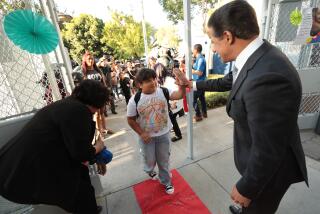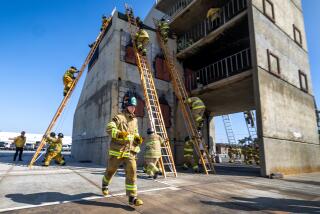Figuratively Speaking, Statistics Tell Interesting Tale
- Share via
One of my favorite Christmas rituals is burrowing through the education reports and statistics released annually by the National Center for Education Statistics, U.S. Department of Education, National Education Assn., Bureau of the Census, U.S. Department of Commerce, and other agencies.
Why? It’s a good way to get perspective on the status of American education, and how California compares to other states.
The conclusions that can be drawn from such data are complicated and largely subjective, so I’ll leave those to you. Instead, I’ll just give you the numbers I found most telling:
* All told, $229 billion was spent on education by federal and state governments in 1990-91, the most recent school year for which figures are now available.
* California has the largest number of students enrolled in elementary and secondary schools--5,107,145. They’re served by our 1,005 local school districts. Interestingly, Hawaii and Washington, D.C., each make up a single district; Texas has the most school districts (1,051).
* About 91% of 5- to 17-year-olds in the United States were enrolled in school last year.
* The average amount spent on each student in public schools last year was $5,245.
* The District of Columbia spent the most per pupil ($9,259), while Utah spent the least ($2,960), and California ranked near the middle ($4,491).
* As for student-teacher ratios, the national average is 17.3 students per teacher, with the District of Columbia the best (13.2), Utah the worst (24.9), and California not much better (22.8).
* Now for some news in an area very dear to my heart: teacher salaries. The national average dropped from $34,385 per year in the 1990-91 school year to $34,098 last school year. State by state, Connecticut still holds the top spot in teachers’ annual pay ($46,971 on average). South Dakota is the least lucrative ($23,291), and California’s teachers average $40,192 annually.
I suspect that part of the reason teachers are paid less than their equally educated counterparts in other professions is that teaching is still a female-dominated occupation. Indeed, only about 27.1% of all U.S. public school teachers are male. California beats that average (with 30.3%), and Massachusetts has the highest proportion (37.9%), while Georgia has the fewest male teachers (16.9%).
* The total number of students with disabilities rose from 4,255,000 in the 1982-83 school year to 4,771,000 in 1990-91. Learning disabilities rose from 1,741,000 in 1982-83 to 2,130,000 in 1990-91. Numbers of students with the following disabilities decreased: impairments of hearing, vision, or speech; orthopedic impairments and mental retardation.
* Finally, a statistic that is fairly new to the pool: the use of personal computers in public schools. In 1981, only 18.2% of the nation’s public schools housed computers for student use. As of 1990, that number soared to 97.2%.
Next week I’ll boil down what these and similar reports say about college and university life.






